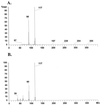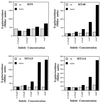Indole can act as an extracellular signal in Escherichia coli
- PMID: 11418561
- PMCID: PMC95310
- DOI: 10.1128/JB.183.14.4210-4216.2001
Indole can act as an extracellular signal in Escherichia coli
Abstract
Previous work has shown that lacZ fusions to the cysK, astD, tnaB, and gabT genes in Escherichia coli are activated by self-produced extracellular signals. Using a combination of ethyl acetate extraction, reversed-phase C(18) chromatography, and thin-layer chromatography, we have purified an extracellular activating signal from E. coli supernatants. Mass spectrometry revealed a molecule with an m/z peak of 117, consistent with indole. Nuclear magnetic resonance analysis of the purified E. coli factor and synthetic indole revealed identical profiles. Using synthetic indole, a dose-dependent activation was observed with lacZ fusions to the gabT, astD, and tnaB genes. However, cysK::lacZ and several control fusions were not significantly activated by indole. Conditioned medium prepared from a tnaA (tryptophanase) mutant, deficient in indole production, supported 26 to 41% lower activation of the gabT and astD fusions. The residual level of activation may be due to a second activating signal. Activation of the tnaB::lacZ fusion was reduced by greater than 70% in conditioned medium from a tnaA mutant.
Figures




References
-
- Bassler B L, Wright M, Showalter R E, Silverman M R. Intercellular signalling in Vibrio harveyi: sequence and function of genes regulating expression of luminescence. Mol Microbiol. 1993;9:773–786. - PubMed
-
- Cao J G, Meighen E A. Purification and structural identification of an autoinducer for the luminescence system of Vibrio harveyi. J Biol Chem. 1989;264:21670–21676. - PubMed
-
- Cheng Q, Campbell E A, Naughton A M, Johnson S, Masure H R. The com locus controls genetic transformation in Streptococcus pneumoniae. Mol Microbiol. 1997;23:683–692. - PubMed
-
- Davies D G, Parsek M R, Pearson J P, Iglewski B H, Costerton J W, Greenberg E P. The involvement of cell-to-cell signals in the development of a bacterial biofilm. Science. 1998;280:295–298. - PubMed
Publication types
MeSH terms
Substances
LinkOut - more resources
Full Text Sources
Molecular Biology Databases

